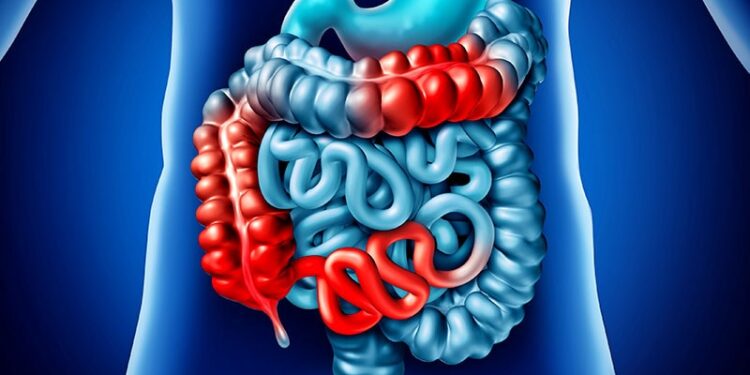WASHINGTON, DC — A low-emulsifier-containing diet led to a threefold increased likelihood of improvement in symptoms of Crohn’s disease compared with an emulsifier-containing diet in a randomized double-blind dietary trial involving 154 patients with mildly active disease living across the United Kingdom.
The findings were reported at Gut Microbiota for Health (GMFH) World Summit 2025 by Benoit Chassaing, PhD, of the Institut Pasteur, Paris, France, whose research leading up to the trial has demonstrated that food additive emulsifiers —ubiquitous in processed foods — alter microbiota composition and lead to microbiota encroachment into the mucus layer of the gut and subsequent chronic gut inflammation.
Patients in the ADDapt trial, which was also reported in an abstract earlier this year at the European Crohn’s and Colitis Organization (ECCO) 2025 Congress, had a Crohn’s disease activity index (CDAI) of 150-250 and evidence of inflammation (faecal calprotectin (FCP) ≥ 150 µg/g or endoscopy/radiology). All “had been exposed in their regular diets to emulsifiers,” said Chassaing, a co-investigator, during a GMFH session on “Dietary Drivers of Health and Disease.”
They were randomized to either a low-emulsifier diet or to a low-emulsifier diet followed by emulsifier “resupplementation” — a design meant to “account for the very strong placebo effect that is always observed with dietary studies,” he said.
All patients received dietary counseling, a smart phone app and barcode scan to support shopping, and weekly support. They also received supermarket foods for 25% of their needs that were either free of emulsifiers or contained emulsifiers, and they were provided three snacks per day that were emulsifier-free or contained carrageenan, carboxymethycellulse (CMC), and polysorbate-80 (P80) — dietary emulsifiers that are commonly added to processed foods to enhance texture and extend shelf-life.
In the intention-to-treat (ITT) analysis, 49% of patients in the intervention group reached the primary endpoint of a 70-point reduction or more in CDAI response after 8 weeks compared with 31% of those in the control group (P = .019), with an adjusted relative risk of response of 3.1 (P = .003), Chassaing shared at the GMFH meeting, convened by the American Gastroenterological Association and the European Society of Neurogastroenterology and Motility.
In the per-protocol analysis (n = 119), 61% and 47% of patients in the intervention and control groups, respectively, reached the primary outcome of CDAI response, with an adjusted relative risk of response of 3.0 (P = .018), he said.
Secondary endpoints included CDAI remission at 24 weeks, and according to the abstract for the ECCO Congress, in the ITT analysis, patients in the intervention group were more than twice as likely to experience remission.
Chassaing noted at the GMFH meeting that as part of the study, he and coinvestigators have been investigating the participants’ gut microbiota with metagenomic analyses. The study was led by Kevin Whelan, head of the Department of Nutritional Sciences at King’s College London, London, England.
Can Emulsifier-Sensitive Individuals Be Identified?
In murine model research 10 years ago, Chassaing showed that the administration of CMC and P80 results in microbiota encroachment into the mucus layer of the gut, alterations in microbiota composition — including an increase in bacteria that produce pro-inflammatory flagellin — and development of chronic inflammation.
Wild-type mice treated with these compounds developed metabolic disease, and mice that were modified to be predisposed to colitis had a higher incidence of robust colitis. Moreover, fecal transplantation from emulsifier-treated mice to germ-free mice reproduced these changes, “clearly suggesting that the microbiome itself is sufficient to drive chronic inflammation,” he said.
In recent years, in humans, analyses from the large French NutriNet-Sante prospective cohort study have shown associations between exposure to food additive emulsifiers and the risk for cardiovascular disease, the risk for cancer (overall, breast, and prostate), and the risk for type 2 diabetes.
But to explore causality and better understand the mechanisms of emulsifier-driven changes on the microbiota, Chassaing and his colleagues also launched the FRESH study (Functional Research on Emulsifier in Humans), a double-blind randomized controlled-feeding study of the emulsifier CMC. For 11 days, nine healthy patients consumed an emulsifier-free diet and 11 consumed an identical diet enriched with 15 g/d of CMC.
Patients on the CMC-containing diet had reduced microbiota diversity and depletions of an array of microbiota-related metabolites, but only a small subset had profound alterations in microbiota composition and increased microbiota encroachment into the mucus layer. “Some seemed to be resistant to CMC-induced microbiota encroachment, while some were highly susceptible,” Chassaing said.
The pilot study raised the question, he said, of whether there is an “infectivity component” — some kind of “sensitive” gut microbiota composition — that may be associated with dietary emulsifier-driven inflammation and disease.
In other murine research, Chassaing and his team found that germ-free mice colonized with Crohn’s disease-associated adherent-invasive E coli (AIEC) and subsequently given CMC or P80 developed chronic inflammation and metabolic dysregulation, “clearly demonstrating that you can convert resistant mice to sensitive mice just by adding one bacteria to the ecosystem,” he said. “The presence of AIEC alone was sufficient to drive the detrimental effects of dietary emulsifiers.”
(In vitro research with transcriptomic analysis then showed that the emulsifiers directly elicit AIEC virulence gene expression, Chassaing and his coauthors wrote in their 2020 paper, facilitating AIEC’s “penetration of the mucus layer and adherence to epithelial cells and resulting in activation of host pro-inflammatory signaling.”)
“We don’t think it’s solely the AIEC bacteria that will drive emulsifier sensitivity, though…we think it’s more complex,” Chassaing said at the meeting. Overall, the findings raise the question of whether emulsifier-sensitive individuals can be identified.
This, he said, is one of his most recent research questions. His lab has led the development of an in vitro microbiota model built to predict an individual’s sensitivity to emulsifiers. In a study published in April, the model recapitulated the differential CMC sensitivity observed in the earlier FRESH study, suggesting that an individual’s sensitivity to emulsifiers can indeed be predicted by examining their baseline microbiota.
Interpreting the Epidemiology
Chassaing’s research arch illustrates the synergy between epidemiological research, basic/translational research, and clinical interventional research that’s needed to understand the diet-microbiome intersection in inflammatory bowel disease, said Ashwin Ananthakrishnan, MBBS, MPH, associate professor of medicine at Massachusetts General Hospital, Boston, in an interview at the meeting.
“It’s a good example of how to really span the spectrum, starting from the big picture and going deeper to understand mechanisms, and starting from mechanisms and expanding it out,” Ananthakrishnan said.
In his own talk about research on IBD, Ananthakrishnan said that epidemiological data have shown over the past 10-15 years that total dietary fiber is inversely associated with the risk for Crohn’s disease (with the strongest associations with fiber from fruits and vegetables). Studies have also shown that a higher intake of polyunsaturated fatty acids is associated with a lower risk for ulcerative colitis, whereas “an n-6-fatty acid-rich diet is associated with a higher risk of ulcerative colitis,” he said.
Dietary cohort studies, meanwhile, have shed light on the influence of dietary patterns — such as the Mediterranean diet and diets with high inflammatory potential—on IBD. A diet rich in ultra-processed foods has also been shown in a prospective cohort study to be associated with a higher risk for Crohn’s disease, with certain categories of ultra-processed foods (eg, breads and breakfast foods) having the strongest associations.
Such studies are limited in part, however, by inadequate assessment of potentially relevant variables such as emulsifiers, preservatives, and how the food is processed, he said.
And in interpreting the epidemiological research on fiber and IBD, for instance, one must appreciate that “there are a number of mechanisms by which fiber is impactful…there’s a big picture to look at,” Ananthakrishnan said. Fiber “can affect the microbiome, clearly, it can affect the gut barrier, and it can affect bile acids, and there are detailed translational studies in support of each of these.”
But there are other constituents of fruits and vegetables “that could potentially influence disease risk, such as AhR ligands and polyphenols,” he said. “And importantly, people not eating a lot of fiber may be eating a lot of ultra-processed foods.”
Most interventional studies of fiber have not shown a benefit of a high-fiber diet, Ananthakrishnan said, but there are multiple possible reasons and factors at play, including potential population differences (eg, in inflammatory status or baseline microbiota), shortcomings of the interventions, and potentially inaccurate outcomes.
Abigail Johnson, PhD, RDN, associate director of the Nutrition Coordinating Center, University of Minnesota Twin Cities, which supports dietary analysis, said during the session that the focus of dietary research is “moving toward understanding overall dietary patterns” as opposed to focusing more narrowly on vitamins, minerals, and macronutrients such as proteins, fats, and carbohydrates.
This is an improvement, though “we still don’t have good approaches for understanding [the contributions of] things like additives and emulsifiers, food preparation and cooking, and food processing,” said Johnson, assistant professor in the Division of Epidemiology and Community Health at University of Minnesota Twin Cities. “Perhaps by looking at things at the food level we can overcome some of these limitations.”
Ananthakrishnan reported being a consultant for Geneoscopy and receiving a research grant from Takeda. Chassaing did not report any financial disclosures. Johnson reported that she had no financial disclosures.
Source link : https://www.medscape.com/viewarticle/dietary-trial-shows-benefits-low-emulsifier-diet-crohns-2025a1000j4g?src=rss
Author :
Publish date : 2025-07-18 12:54:00
Copyright for syndicated content belongs to the linked Source.








